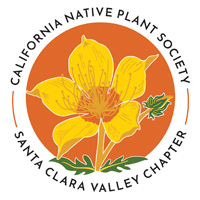by Carolyn Dorsch
Eighteen people, including trip leaders Stella Yang and Carolyn Dorsch headed up to the Sierras the first weekend of August. We camped off of Hwy 120, at 6,200 feet, near the Clark Fork of the Stanislaus River. The first day we stayed in the “lowlands,” and explored along the Clark Fork meadow and the Column of the Giants.
Day Two found us up near the top of Hwy 120, just a little west of Sonora Pass. We spent the day hiking up to St. Mary’s Pass (10,100 feet). The walk was steadily uphill, but with wildflowers all along the way, low 70s temperature, and nice breezes, the 1,200 foot climb from the trailhead was quite manageable. Along the way, and at the top of the pass we found many high-elevation flora blooming, including the following: Pursh’s wooly-pod (Astragalus purshii), Buckwheat (Eriogonum ovalifolium), Sierra Claytonia (Claytonia nevadensis), and Arctic Willow (Salix arctica). In fruit were two anemones: A. occidentalis and A. drummondii. All together, it was about a three-mile round trip. A couple people took the challenge offered by the mountains, and continued their hike up to Stanislaus Peak (11,233 feet) before rejoining the group back at the trailhead in the late afternoon.
Day Three, as a final stop before heading home, we drove down Herring Creek Road. While it can be stunning in June (elevation around 7,000 feet), we had to work harder to find the flowers. Following the water, we came across beautiful colonies of Alpine Lily (Lilium parvum) near Herring Creek. The trip was capped off with a short visit along the Trail of the Gargoyles, where we could admire the amazing geologic formations. Plans are already in motion for another trip up to the Sonora Pass area.
Late June/early July is the best time to see the flowers at the 6-7,000 feet elevation, but there is plenty to see in early August, so long as you go to the higher elevations. Look for this trip’s highlights at a Member’s Night meeting later in the year!

